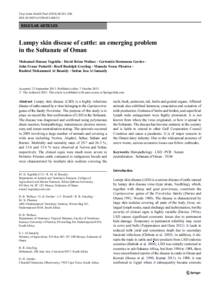وثيقة
Lumpy skin disease of cattle : an emerging problem in the Sultanate of Oman.
المعرف
DOI: 10.1007/s11250-013-0483-3
المساهمون
Wallace, David Brian., مؤلف
Putterill, John Fraser., مؤلف
Greyling, Roelf Rudolph., مؤلف
Phosiwa, Maanda Noaxe., مؤلف
الناشر
Kluwer Academic Publishers.
ميلادي
2014-01
اللغة
الأنجليزية
الموضوع
الملخص الإنجليزي
Lumpy skin disease (LSD) is a highly infectious disease of cattle caused by a virus belonging to the Capripoxvirus genus of the family Poxviridae. The purpose of this study is to place on record the first confirmation of LSD in the Sultanate. The disease was diagnosed and confirmed using polymerase chain reaction, histopathology, transmission electron microscopy and serum neutralization testing. The epizootic occurred in 2009 involving a large number of animals and covering a wide area including Nezwa, Alqabel, Sohar, Saham and Burimi. Morbidity and mortality rates of 29.7 and 26.3 %, and 13.6 and 15.4 % were observed at Nezwa and Sohar, respectively. The clinical signs were much more severe in Holstein-Friesian cattle compared to indigenous breeds and were characterized by multiple skin nodules covering the neck, back, perineum, tail, limbs and genital organs. Affected animals also exhibited lameness, emaciation and cessation of milk production. Oedema of limbs and brisket, and superficial lymph node enlargement were highly prominent. It is not known from where the virus originated, or how it spread to the Sultanate. The disease has become endemic in the country and is liable to extend to other Gulf Cooperation Council Countries and cause a pandemic. It is of major concern to the Omani dairy industry. Due to the widespread presence of screw worm, serious economic losses can follow outbreaks.
المجموعة
ISSN
0049-4747
URL المصدر
قالب العنصر
مقالات الدوريات


